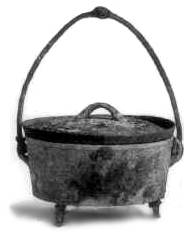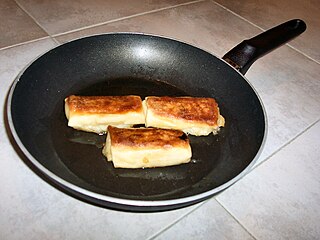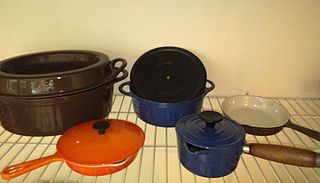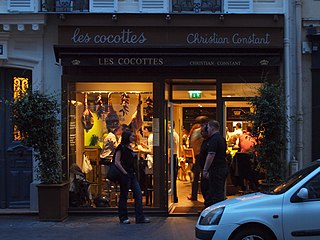
Cookware and bakeware is food preparation equipment, such as cooking pots, pans, baking sheets etc. used in kitchens. Cookware is used on a stove or range cooktop, while bakeware is used in an oven. Some utensils are considered both cookware and bakeware.

Outdoor cooking is the preparation of food in the outdoors. A significant body of techniques and specialized equipment exists for it, traditionally associated with nomad in cultures such as the Berbers of North Africa, the Arab Bedouins, the Plains Indians, pioneers in North America, and indigenous tribes in South America. These methods have been refined in modern times for use during recreational outdoor pursuits, by campers and backpackers.

A Dutch oven or casserole dish (international) is a thick-walled cooking pot with a tight-fitting lid. Dutch ovens are usually made of seasoned cast iron; however, some Dutch ovens are instead made of cast aluminum, or ceramic. Some metal varieties are enameled rather than being seasoned, and these are sometimes called French ovens. The international name casserole dish is from the French casserole which means "cooking pot". They are similar to both the Japanese tetsunabe and the sač, a traditional Balkan cast-iron oven, and are related to the South African potjie, the Australian Bedourie oven and Spanish cazuela.

An oven is a tool which is used to expose materials to a hot environment. Ovens contain a hollow chamber and provide a means of heating the chamber in a controlled way. In use since antiquity, they have been used to accomplish a wide variety of tasks requiring controlled heating. Because they are used for a variety of purposes, there are many different types of ovens. These types differ depending on their intended purpose and based upon how they generate heat.

A tava(h) / tawa(h) (mainly on the Indian subcontinent), saj (in Arabic), sac (in Turkish), and other variations and combinations thereof, is a metal-made cooking utensil. The tawa is round and can be flat, but more commonly has a curved profile, and while the concave side can be used as a wok or frying pan, the convex side is used for cooking flatbreads and pancakes.

Le Creuset is a French-Belgian maker of cookware. They are best known for producing enameled cast-iron cookware. The company first manufactured their products in the town of Fresnoy-le-Grand in France in 1925, which are similar in function to a Dutch oven but with T-shaped handles. The Le Creuset Dutch oven is on display in the Smithsonian Institution's National Museum of American History in Washington, D.C. as a part of the recreation of the chef Julia Child's kitchen. It has been widely reported to be her favorite cooking pot, though specialist sources hold that it was the Dutch oven of Le Creuset's less-remembered competitor Descoware that was her real favorite. The company also makes many other types of cookware and bakeware, from fondue-sets to tagines.

Heavy-duty cookware made of cast iron is valued for its heat retention, durability, ability to maintain high temperatures for longer time duration, and non-stick cooking when properly seasoned. Seasoning is also used to protect bare cast iron from rust. Types of cast-iron cookware include frying pans, dutch ovens, griddles, waffle irons, flattop grills, panini presses, crepe makers, deep fryers, tetsubin, woks, potjies, and karahi.

Lodge Manufacturing Company is an American manufacturer of cast-iron cookware based in South Pittsburg, Tennessee. Founded in 1896 by Joseph Lodge, Lodge Manufacturing is one of America's oldest cookware companies in continuous operation. It is still owned and managed by the descendants of the Lodge family. Most cast iron sold by Lodge is produced in its foundry in South Pittsburg, which has been in operation since the company was founded.

A Dutch baby pancake, sometimes called a German pancake, a Bismarck, a Dutch puff, Hooligan, or a Hootenanny, is a dish that is similar to a large Yorkshire pudding.

Brasserie Les Halles was a French-brasserie-style restaurant located on 15 John Street in Manhattan, New York City. Previous locations were on Park Avenue South in Manhattan, in Tokyo, Miami, and Washington, D.C. Author and television host Anthony Bourdain was the predecessor to the executive chef of Brasserie Les Halles, Carlos Llaguno. The restaurant went bankrupt in August 2017.

Descoware is a discontinued brand of porcelain- or enamel-coated cast-iron cookware Among notable Descoware pots are dutch ovens. Although Descoware is now little-remembered, specialist sources hold that it was the favorite cooking ware of American cooking instructor and television personality Julia Child, more so than Le Creuset, whose association with the chef has been widely reported. Child regularly used Descoware on her television show The French Chef. The Smithsonian Institution's installation about Child's kitchen featured a large orange Descoware pot on top of Child's own stove.

A non-stick surface is engineered to reduce the ability of other materials to stick to it. Non-stick cookware is a common application, where the non-stick coating allows food to brown without sticking to the pan. Non-stick is often used to refer to surfaces coated with polytetrafluoroethylene (PTFE), a well-known brand of which is Teflon. In the twenty-first century, other coatings have been marketed as non-stick, such as anodized aluminium, silica, enameled cast iron, and seasoned cookware.

Cousances was a brand of enameled cast iron cookware. originally manufactured by a foundry in the town of Cousances-les-Forges in northeastern France. The Cousances foundry began making cast iron pans in 1553. Four centuries later, in 1957, the brand was acquired by Le Creuset. Cookware under the Cousances brand continued to be manufactured by Le Creuset into the early 1980s.

Seasoning is the process of coating the surface of cookware with fat which is heated in order to produce a corrosion resistant layer of polymerized fat. It is required for raw cast-iron cookware and carbon steel, which otherwise rust rapidly in use, but is also used for many other types of cookware. An advantage of seasoning is that it helps prevent food sticking.

Druware, also known as DRU Holland cookware and Royal Dru, was a line of porcelain-enamel-coated cast-iron cookware made by the De Koninklijke Diepenbrock & Reigers of Ulft (DRU) company in Achterhoek, Netherlands.

Griswold Manufacturing was an American manufacturer of cast-iron kitchen products founded in Erie, Pennsylvania, in business from 1865 through 1957. For many years the company had a world-wide reputation for high-quality cast-iron cookware. Today, Griswold pieces are collectors' items.

Christian Constant is a French chef and entrepreneur.

Zwilling J. A. Henckels AG is a German knife-maker based in Solingen, Germany. It is one of the largest and oldest manufacturers of kitchen knives for domestic and professional use, having been founded in June 1731 by Peter Henckels. It is also one of the oldest operating companies in the world. The brand's namesake was Johann Abraham Henckels (1771–1850), who renamed the brand after himself under his leadership. J. A. Henckels is one of the leading manufacturers of chef's knives. Since 1970, Zwilling is fully owned by Werhahn KG. The following brands belong to the Zwilling Group: ZWILLING, HENCKELS, Miyabi, BSF, Demeyere, Staub, Fontignac, Ballarini, Flammkraft, and Santos Grills.


















